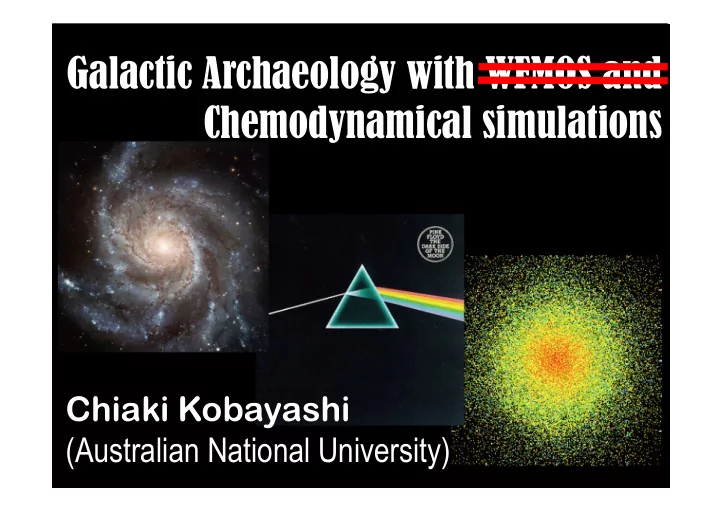

Galactic Archaeology with WFMOS and Chemodynamical simulations Chiaki Kobayashi (Australian National University)
Chemodynamical Simulation Evolution of Baryon? � + Supernova SPH � Hydrodynamics, (SN&HN) + Feedback Radiative Cooling, + Chemical Star Formation Enrichment SF � SN � GW �
Mass-Metallicity Relation � ○ Cosmological Simulation (CK, Springel, White 2007) � Savaglio et al. 05 � Tremonti et al. 04 � Maiolino , Nagao, et al. 08 � Erb et al. 06 �
Metallicity Gradients of Ellipticals � □ GRAPE Simulations of 120 Es (CK 2004, 2005) � GMOS � Spolaor, CK, et al. 2009 �
Chemical Enrichment � Gravity Hydrodynamics Star Formation? Feedback? [Fe/H] and [X/Fe] evolve in a galaxy: fossils to tell the evolution history of the galaxy → Galactic Archaeology
Model with SN only HN AGB Karakas & Lattanzio 2007, Karakas 2009 �
Model with SN only HN AGB Karakas & Lanttanzio 2007, Hirschi 2007 �
The Milky Way Galaxy Initial Condition: λ CDM fluctuated sphere with λ ~0.1, r~3Mpc, M tot ~10 12 M , N tot ~120.000, M gas ~10 6 M , M DM ~10 7 M Gas � Star �
Star Formation Rate � Bulge r<1, Solar Neighborhood: 7.5<r<8.5,|z|<0.5 kpc
Age Metallicity Relation Observational Data: ・ Nordstrom et al. (2004) for the solar neighborhood
Age Metallicity Relation Observational Data: ・ Nordstrom et al. (2004) for the solar neighborhood
[O/Fe]-[Fe/H] Relation Observational Data: Not only O, Edvardsson et al. (1993), Bensby et al. (2003), But also Mg, Si, S, Ca � Gratton et al. (2003), Cayrel et al. (2004) for the solar neighborhood
[O/Fe]-[Fe/H] Relation Observational Data: Not only O, Edvardsson et al. (1993), Bensby et al. (2003), But also Mg, Si, S, Ca � Gratton et al. (2003), Cayrel et al. (2004) for the solar neighborhood
[X/Fe]-[Fe/H] relations � Solar Neighborhood �
[X/Fe]-[Fe/H] relations � Solar Neighborhood �
Summary � ✷ Chemodynamical Simulation of the Galaxy ★ reproduce the difference of stellar population in bulge/disk ★ predict the Frequency Distribution of Elemental Abundances as a function of time and location ✷ To be compared with… ★ Homogeneous Dataset of a million stars, ~100 EMP stars ★ High-resolution (R>20,000) → from Li to Eu ✷ Chemical Enrichment Sources HN � 1-10 Myr � low Z � Fe, Zn, α � SN II � 1?-100 Myr � O, Mg, α , r? � SN Ia � 0.1-20 Gyr � high Z � Fe, Mn � AGB � 0.1-20 Gyr � C, N, Li, s? �
Summary � ✷ Chemodynamical Simulation of the Galaxy ★ reproduce the difference of stellar population in bulge/disk ★ predict the Frequency Distribution of Elemental Abundances as a function of time and location ✷ To be compared with… ★ Homogeneous Dataset of a million stars, ~100 EMP stars ★ High-resolution (R>20,000) → from Li to Eu ✷ Also for many studies… ★ Chemical Tagging (Freeman & Bland-Hawthorn 04) ★ Supernova Physics, Connection with GRB ★ O-Na/Mg-Al anti-correlation (Stellar Astrophysics) ★ Li problem (Nuclear Astrophysics? Cosmology??)
Recommend
More recommend